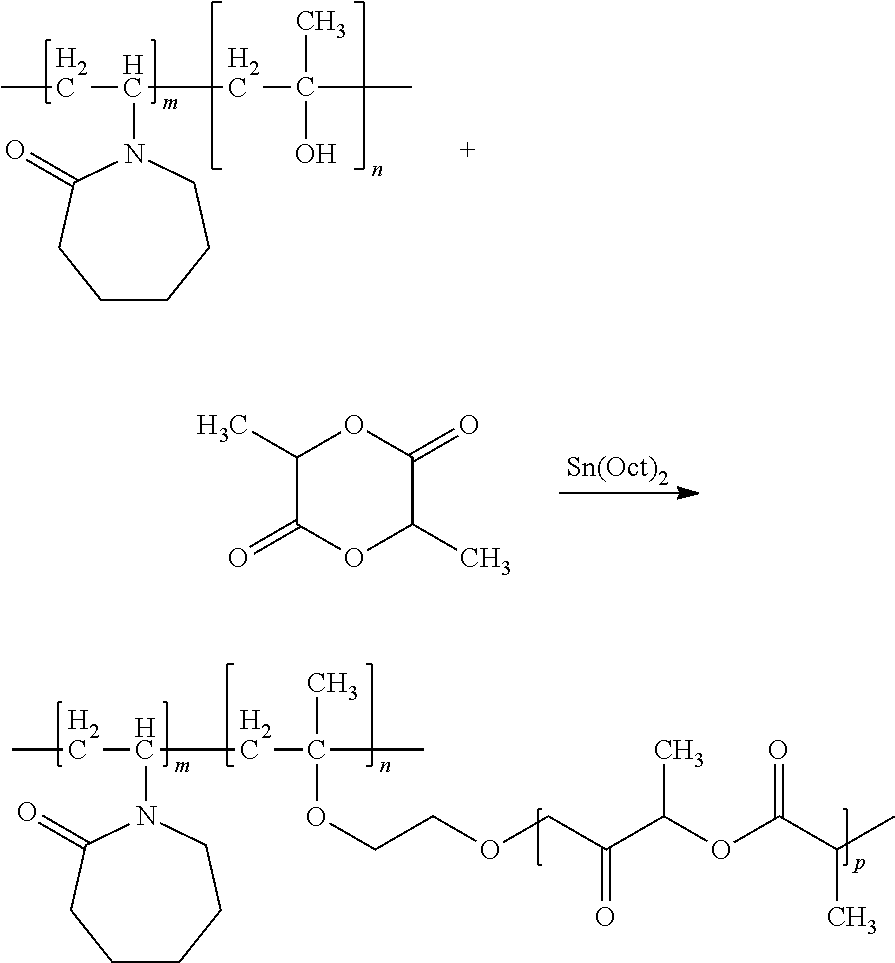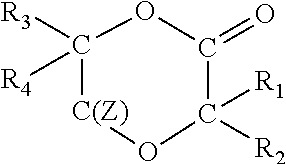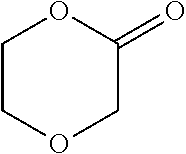Degradable polymer compositions and uses thereof
a technology of polymer composition and composition, which is applied in the field of degradable polymers, can solve the problems of large pressure drop, unnecessarily consuming landfill capacity, and affecting the integrity of construction materials,
- Summary
- Abstract
- Description
- Claims
- Application Information
AI Technical Summary
Benefits of technology
Problems solved by technology
Method used
Image
Examples
example 1
Synthesis of poly(92.6% VCAP-co-4.9% HEMA)-g-(2.54% PLA)
Production of poly(95% VCAP-co-5% HEMA) in BGE with Initiator
[0151]
[0152]Preparation of feed solution #1: N-vinyl-2-caprolactam (VCAP) (9.5 g) and hydroxyethyl methacrylate (HEMA) (0.5 g) were codissolved in 2-butoxyethanol (BGE) (40 g).
[0153]Preparation of feed solution #2: N-vinyl-2-caprolactam (85.5 g) and hydroxyethyl methacrylate (4.5 g) were codissolved in 2-butoxyethanol (60 g).
[0154]Feed solution #1 was charged into the reaction kettle and heated to 116° C. under nitrogen purge. After reaching temperature, a tent-amyl peroxy-2-ethylhexanoate initiator, Trigonox® 121 (0.375 g), was added, and the mixture was stirred for 15 minutes.
[0155]Over a period of 3 hours, feed solution #2 was pumped into the reaction kettle containing feed solution #1, and, simultaneously, 13 charges of Trigonox® 121 (each 0.375 g) were added to the reactor every 15 minutes.
[0156]After the last charge of Trigonox® 121 the reaction kettle was coole...
example 2
Synthesis of poly(47% VCAP-co-11.6% VOH)-g-(40% PLA)
Production of poly(80% VCAP-co-20% VOH)
[0164]
[0165]Preparation of feed solution #1: N-vinyl-2-caprolactam (168 g), and vinyl acetate (72 g) were dissolved in methanol (50 g).
[0166]Preparation of feed solution #2: Luperox® 11 M75 (21.6 g), a tert-butyl peroxypivalate initiator, was dissolved in methanol (50 g).
[0167]A 1-L stainless steel reactor was fitted with propeller agitator, reflux condenser, nitrogen inlet tube and thermocouple reactor. Methanol (250 g) was added, and then, under nitrogen purge, was heated to 80° C.
[0168]Then, all of feed solution #1 and a portion of feed solution #2 (60.8 g) were fed into the reactor over 180 minutes. After 15 minutes, the remainder of feed solution #2 was charged over 30 minutes.
[0169]After another one hour reaction, the reactor was cooled down to room temperature. The product obtained from the polymerization reaction was a brown, viscous copolymer of poly(VCAP-co-VAc) (70 / 30 mass ratio) in...
PUM
| Property | Measurement | Unit |
|---|---|---|
| Fraction | aaaaa | aaaaa |
| Fraction | aaaaa | aaaaa |
| Fraction | aaaaa | aaaaa |
Abstract
Description
Claims
Application Information
 Login to View More
Login to View More - R&D
- Intellectual Property
- Life Sciences
- Materials
- Tech Scout
- Unparalleled Data Quality
- Higher Quality Content
- 60% Fewer Hallucinations
Browse by: Latest US Patents, China's latest patents, Technical Efficacy Thesaurus, Application Domain, Technology Topic, Popular Technical Reports.
© 2025 PatSnap. All rights reserved.Legal|Privacy policy|Modern Slavery Act Transparency Statement|Sitemap|About US| Contact US: help@patsnap.com



